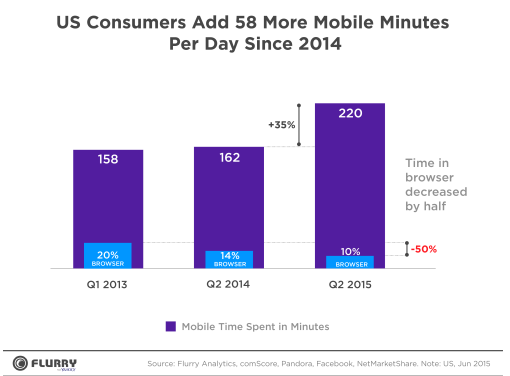Yahoo: The Decline Of The Mobile Browser Is A Threat To Search
App time has grown to 90 percent while browser time has slipped to 10 percent.
Earlier this week Yahoo held its second Mobile Developer Conference in New York. This was the East Coast version of its inaugural developer conference held in San Francisco earlier this year.
As part of that event, which I did not attend, Simon Khalaf, Yahoo’s SVP Publishing Products, took the stage to deliver a kind of “state of mobile” talk that was full of data. The highlights are reproduced in a Tumblr post.
Yahoo reported that time with apps continues to grow, while mobile browser time continues to decline. In 2014, according to Flurry/Yahoo US smartphone owners spent 14 percent of their mobile media time with the browser and 86 percent with apps. In Q2 browser time has fallen to 10 percent.

It’s interesting, given Yahoo Gemini and the company’s renewed focus on search, that Khalaf discusses the decline of the browser as as an existential threat to mobile search:
Effectively, the browser has been sidelined on mobile. This has major implications on the digital industry in general and the content and media industry in particular. Historically, the media industry has relied almost entirely on search for user and traffic acquisition, building entire teams around SEO and SEM on the desktop web. But search engines are predominantly accessed from a browser. If mobile users aren’t using browsers, the media industry will have to look for new approaches to content discovery and traffic acquisition.
While this may be a reasonable inference from the data it’s also a not-so-subtle argument for mobile display and native advertising as content promotion/discovery tools for publishers. As the data below indicate, it’s also an argument for content discovery via social platforms.
In the chart below Yahoo points out that “Social, Messaging and Entertainment apps (including YouTube)” consumed 51 percent of mobile user time spent. The entertainment category, dominated by YouTube (and probably Netflix), grew from 13 minutes per day in 2014 to 44 minutes per day in 2015.

On its Q2 earnings call in July Google reported that YouTube watch time is up 60 percent year over year and mobile watch time has doubled since 2014. Google’s Omid Kordestani said that YouTube now reaches more 18–49-year-olds than any US cable network. He added that the average viewing session on mobile is now more than 40 minutes. This suggests that the Yahoo/Flurry 44 minutes per day figure may underestimate time spent with YouTube.
Messaging and Social apps grew from 45 minutes per day to 68 minutes per day in the second quarter. Yahoo’s Khalaf explained that “the majority of time spent inside messaging and social apps is actually spent consuming media.”
One interesting finding in the presentation concerns the decline in mobile gaming, historically a major mobile engagement category. Gaming saw time spent decline from 52 minutes per day last year to 33 minutes today.Yahoo offered several potential explanations:
- Lack of new hits: there hasn’t been a major new [gaming] hit the past 6 to nine months
- Millennials are shifting from playing games to watching others play games
- Gamers are buying their way into games versus grinding their way through them . . . This explains the decline in time spent and the major rise in in-app purchases
The paradox of all this is that while users are spending 90 percent of mobile media time with apps most people concentrate that time in a relatively small number of apps. A survey from Forrester Research, released earlier this year, found that US and UK smartphone owners “use an average of 24 apps per month but spend more than 80 percent of their [in app] time on just five apps.”
This is the true existential crisis for most content publishers not named YouTube (Google), Facebook or Snapchat.



